A Private Tour today in North Norfolk. It was forecast to be windy with April showers, so we set off to see as much as we could while dodging the rain. With native German- and English-speakers, we even managed some instant translation of species names, with a little help from modern technology!
We met in Salthouse this morning. Our first stop was down at Beach Road. A Ruff (Kampfläufer) was feeding on one of the pools beside the road, along with a couple of Avocet (Säbelschnäbler). We had not even got out of the car when we spotted our first Wheatear (Steinschmätzer). There were actually several out on the short grass around the pools. One was nice and close and we got really good views of it through the scope until it flew further back. A few Skylarks (Feldlerche) were flying around as well, with one towering high into the sky singing, despite the weather.
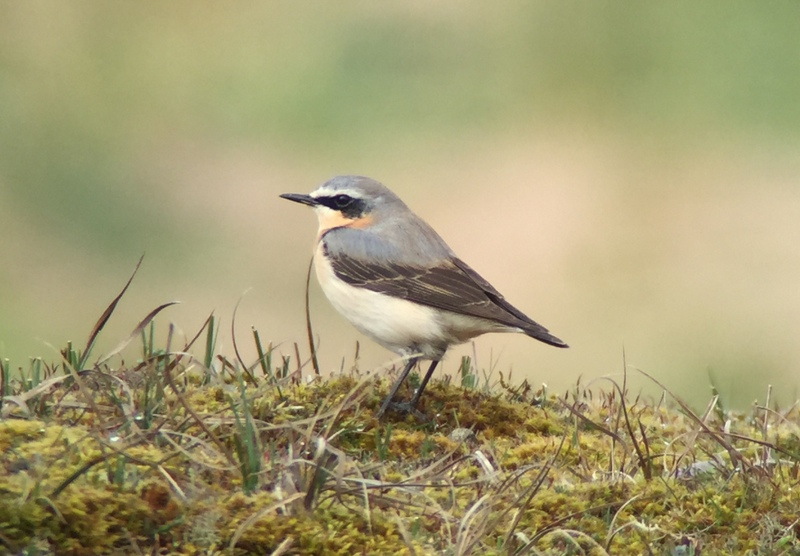 Wheatear – this photo taken a couple of days ago
Wheatear – this photo taken a couple of days ago
There were a few Meadow Pipits (Wiesenpieper) on the move this morning – several flew overhead calling while we stood by the road. Then a squally shower came through and we beat a hasty retreat back to the car. We were just pondering whether to get out again once it passed over when we heard the sharp call of a bird approaching. We got out just in time to see a Yellow Wagtail (Schafstelze) flying towards us. Unfortunately, it didn’t land but continued on west.
The Eye Field at Cley is often a good place to see wagtails on the ground, so we made our way round there next. We pulled up on the road next to the pool just in time to see three wagtails fly across the field towards us and drop in next to the water. These were White Wagtails (Bachstelze), the continental European race of our Pied Wagtail and a regular early migrant along the coast here, most easily distinguished by their pale grey backs rather than the black or darker grey of the Pied Wagtails. We got out of the car and got them in the scope, with just enough time for us all to get a good look at them before they continued on their way. As we were to discover later, there were quite a few White Wagtails on the move today. A Swallow (Rauchschwalbe) swept through too, on its way west.
We parked in the car park and had a quick walk along the path to see if there was anything else in the Eye Field today. The best we could find were a couple more Wheatears – one flew across in front of us, flashing its white tail. A report of an interesting diver had us take a quick look at the sea from the beach shelter, but we couldn’t find it. We did see a single Great Crested Grebe (Haubentaucher) on the water. A couple of Common Scoter (Trauerente) and three Ringed Plovers (Sandregenpfeifer) flew past.
It seemed like a good idea to find a more sheltered spot, so we made our way west along the coast to Holkham. As we pulled up on Lady Anne’s Drive to scan the fields and marshes, another Wheatear flew over the fence and landed on the edge of the road right in front of us. It hopped around picking at the ground for a minute or so, before flying over into the field the other side.
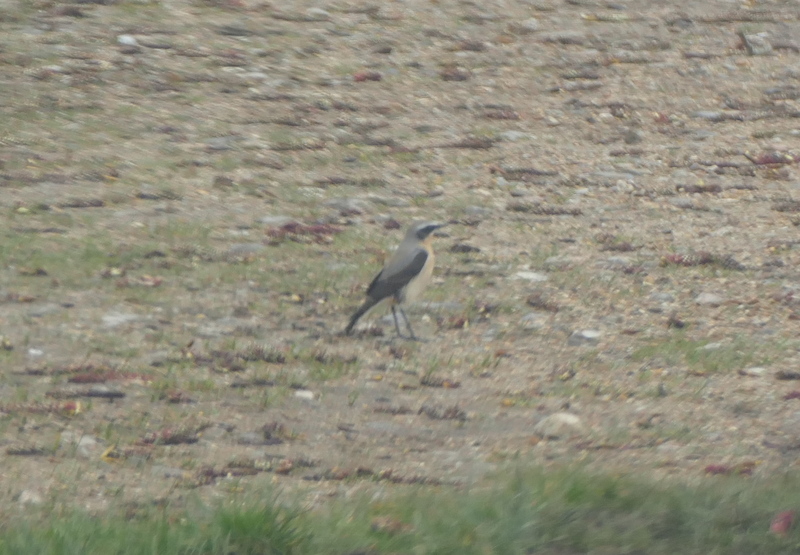 Wheatear – feeding on the edge of Lady Anne’s Drive
Wheatear – feeding on the edge of Lady Anne’s Drive
We got out to have a closer look at the four Pink-footed Geese (Kurzschnabelgans) still out on the grazing marsh. The vast majority of the Pink-footed Geese which spent the worst of the winter here have long since departed, but a few tardy individuals are still lingering here. They were asleep at first but eventually one woke up and started feeding, allowing us a proper view of its dark head and short, dark bill with a pink band around the middle.
A Marsh Harrier (Rohrweihe) flew towards us over the grass. It appeared to be hunting, quartering low across the field. It seemed to spot something and dropped down towards the ground a couple of times, but never actually landed. Whatever it was after was in a dip at first, but when it moved we could see that it was a Brown Hare. When the Marsh Harrier dipped down at it, the Hare started trying to box it away. The pursuit continued for several minutes, the Hare moving a few metres and the Marsh Harrier setting off after it again, before it finally gave up and flew off.
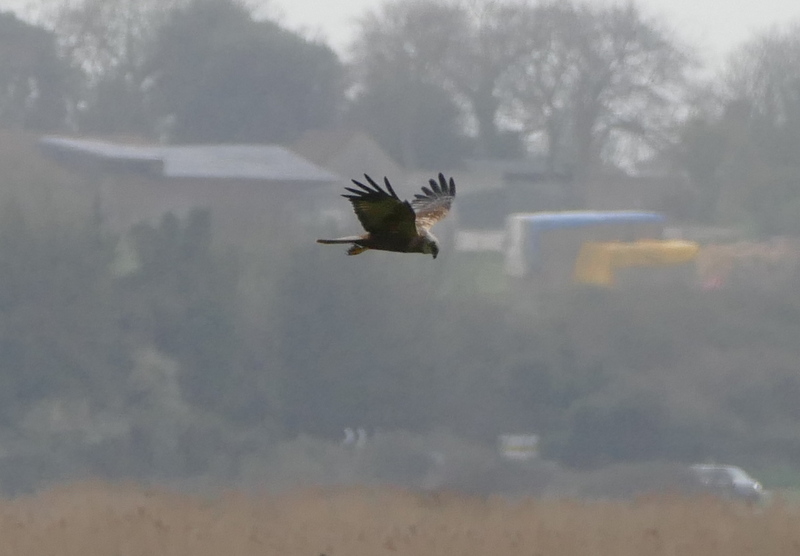 Marsh Harrier – spent several minutes attacking a Brown Hare
Marsh Harrier – spent several minutes attacking a Brown Hare
There was a nice selection of ducks on the floods the other side of the Drive. Some smart Teal (Krickente), a pair of sleeping Shoveler (Löffelente) and a pair or two of Gadwall (Schnatterente). A Grey Heron (Graureiher) was stalking along the edge of the reeds further over.
There were not many other cars on Lady Anne’s Drive today, so we parked right down at the end and set off to walk west. At that point it started to rain, so we sat out the squall in the car. It blew through really quickly on the blustery wind, so we soon continued on our way.
It was more sheltered along the path. The migrant warblers are now starting to return for the summer. There were lots of Chiffchaffs (Zilpzalp) singing in the trees but a Blackcap (Mönchsgrasmücke) was not quite so vocal and immediately went quiet when we stopped to listen to it. A Sedge Warbler (Schilfrohrsänger) was singing away out in the reeds, but we couldn’t see it. Likewise a Cetti’s Warbler (Seidensänger), although this species is one of only two resident rather than migrant warblers. There were lots of tits and Goldcrests (Wintergoldhähnchen) in the holm oaks and a single Treecreeper (Waldbaumläufer) which was uncharacteristically skulking in a dense evergreen. A Mistle Thrush (Misteldrossel) was feeding out on the grass.
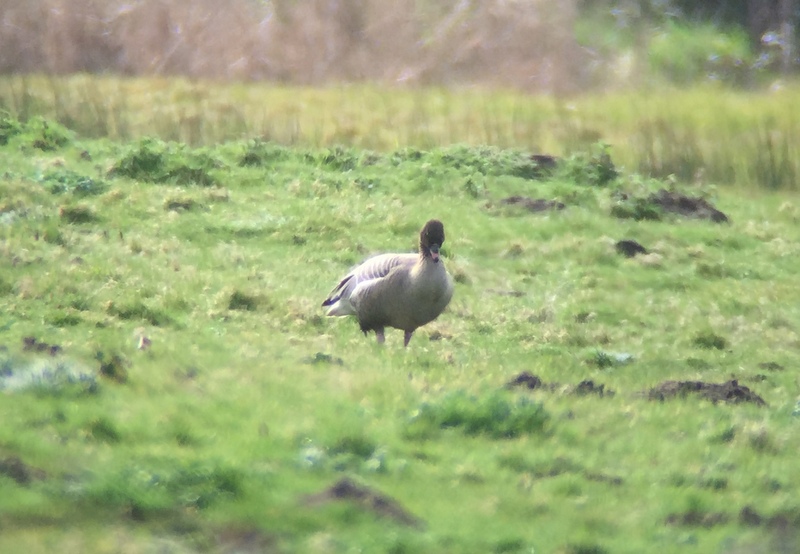 Pink-footed Goose – one of the few still remaining here
Pink-footed Goose – one of the few still remaining here
We stopped to scan the grazing marshes and found another Pink-footed Goose, this one all on its own. With several Greylag Geese (Graugans) nearby, we had a good opportunity to look at the differences between these two species. A few Egyptian Geese (Nilgans) and a pair of Canada Geese (Kanadagans) added to the day’s list, even if neither really belong here! Three Tufted Duck (Reiherente) were on Salt’s Hole.
The Marsh Harriers were displaying over the reedbed. We could hear one calling and watched it circle high up into the air before performing a series of little swoops. A couple of Red Kites (Rotmilan) drifted out from over the pines.
 Red Kite – two drifted overhead from the pines
Red Kite – two drifted overhead from the pines
With a bit of brighter weather, we made our way all the way along as far as Joe Jordan Hide. There was a lot of activity around the trees. The Cormorants (Kormoran) are bust nesting now and birds were continually making their way in and out of the trees with nest material. Little Egrets (Seidenreiher) were coming and going too. We had hoped we might see a Spoonbill (Löffler) or two, but the first large bird we saw fly out of the trees turned out to be something different – a Great White Egret (Silberreiher).
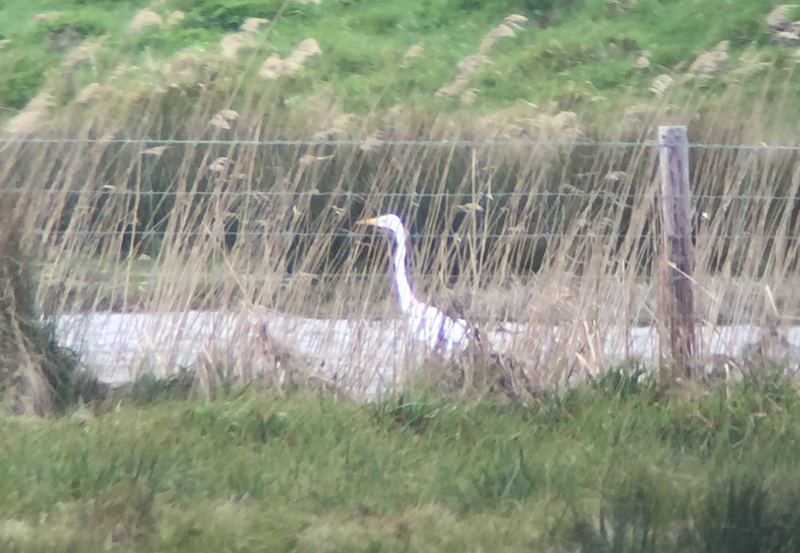 Great White Egret – flew out of the trees and out across the marshes
Great White Egret – flew out of the trees and out across the marshes
The Great White Egret flew across the marshes and eventually landed some distance away on a small pool. Unfortunately it was partly obscured by a fence and thin line of reeds in front, but through the scope we could appreciate its very large size, long neck and very long dagger-shaped yellow-orange bill. Presumably this is still the same bird which we saw regularly over the winter here, although it has not been reported here for a few weeks now. After a while it flew back over and circled over the trees, given us great flight views, before dropping down out of view.
We were given a few tantalising glimpses of Spoonbills in the trees and were planning to start making our way back when we saw another shower approaching. Just as it cleared, a couple of Spoonbills circled up into full view and flew across above the bushes, necks outstretched and showing off their long bills. Perfect timing!
We made our way back to the car and set off back up Lady Anne’s Drive but we hadn’t gone very far when a large white shape on the pool just the other side of the fence caused us to stop and get out again. A Spoonbill was feeding out in the water, head down, sweeping its bill constantly from side to side as it walked. We got it in the scope and had great close up views of it – even the spoon-shaped bill when it periodically stopped feeding momentarily and lifted its head up.
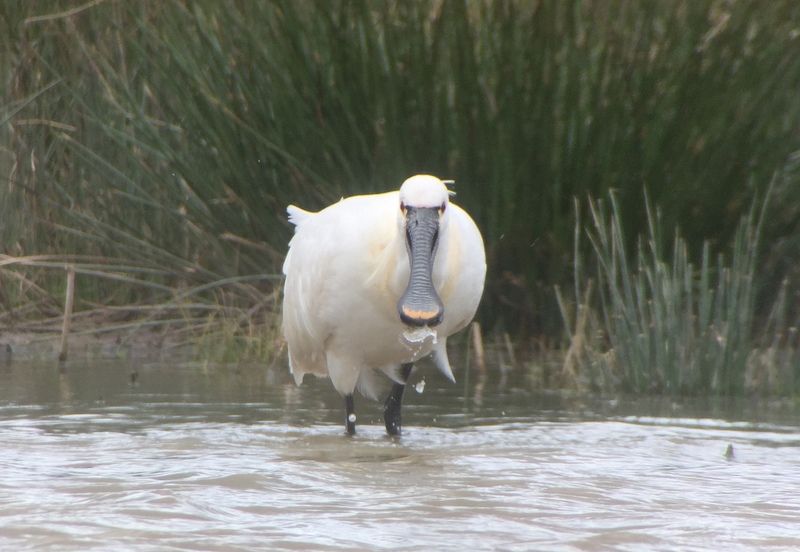 Spoonbill – check out the spoon-shaped bill
Spoonbill – check out the spoon-shaped bill
It was a smart adult in breeding plumage, with a bushy crest on the back of its head, yellow tip to its bill, a bare yellow patch under its chin and a dirty yellowish wash across its breast.
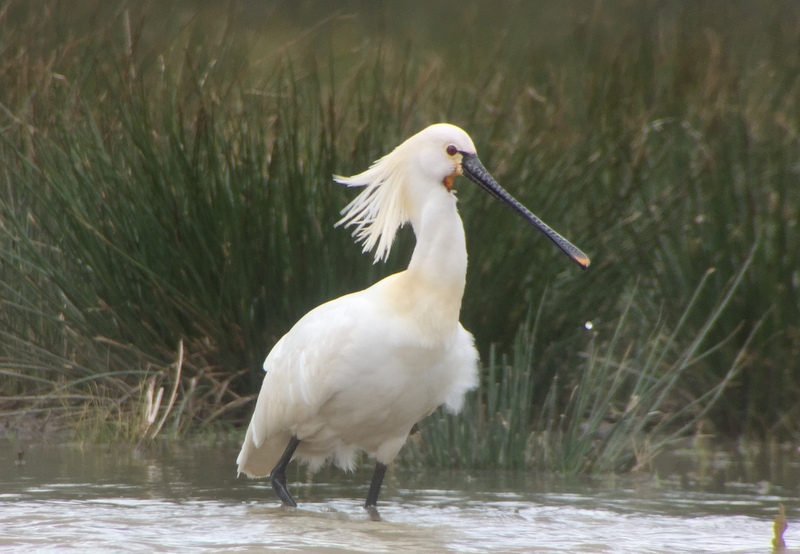 Spoonbill – a very smart adult
Spoonbill – a very smart adult
It was ironic that, having waited to get a view of the Spoonbills at the hide earlier, we were now treated to such stunning views of one right by the road! Still it was a great way to end the morning and in the end we had to tear ourselves away to get some lunch.
After lunch, we made our way back east along the coast. The Lapland Buntings (Spornammer) which have been around Blakeney for most of the winter seem to have largely left now, presumably returned to the continent. However, one or two have been reported still in the last few days so, with the weather improving a bit, it seemed worth a look. We parked by the harbour in Blakeney and set off to walk along the seawall, stopping briefly to admire the bright yellow legs of one of the Lesser Black-backed Gulls (Heringsmöwe).
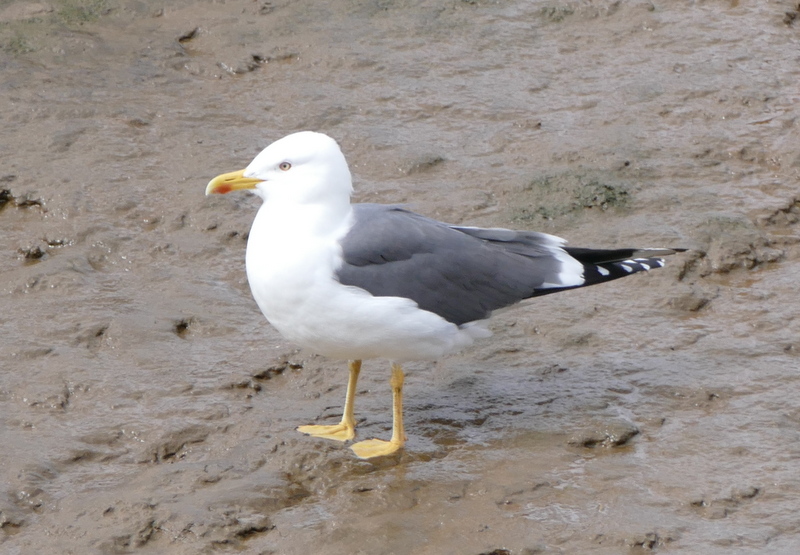 Lesser Black-backed Gull – by the harbour again
Lesser Black-backed Gull – by the harbour again
It was a bit blustery out on the seawall, but not as bad as it might have been. Several flocks of Brent Geese (Ringelgans) flew up from the saltmarsh and flew out towards the Pit. A Curlew (Grosser Brachvogel) was wading deep in the harbour channel and several Oystercatchers (Austernfischer) were nearby.
When we got out to the area where the Lapland Buntings have been favouring in recent weeks, by the gate, all seemed rather quiet. It quickly became clear that the seed which the local photographers had been putting out for them had all been eaten and was no longer being replenished. We had a good look round, up and down the track, but it seemed like we might be out of luck. Several Skylarks were feeding down in the grass, given great views. We had seen a couple more White Wagtails by one of the pools on the walk out and another was tucked in behind a muddy ridge out of the wind, singing. This one we got in the scope and got a much better look at.
 White Wagtail – singing out of the wind
White Wagtail – singing out of the wind
We walked a little further along the seawall, but all we could find were more Skylarks and a Meadow Pipit with a rather rich pink flush to its breast. A glimpse of something distantly in flight, chasing a couple of Skylarks round, looked like it might be a Lapland Bunting, but we lost sight of it before we could get a good look at it. We decided we must be out of luck and started to walk back, stopping to admire a little group of Brent Geese on the edge of the harbour.
 Brent Geese – feeding on the saltmarsh on the edge of the harbour
Brent Geese – feeding on the saltmarsh on the edge of the harbour
When we got back to the gate, a small crowd had gathered. They were looking rather forlornly out across the grass in one direction. As we walked past them, we noticed two small birds in the grass behind them. The first was a Skylark, but the second was a Lapland Bunting, only about two metres from their backs!
It appeared to be a female Lapland Bunting, lacking the black face of the males. It was too close to get the scope on it at first, but we watched with binoculars as it picked around where the seed had previously been spread. As it worked its way back along the path a short distance, we were able to get it in the scope and have a really close look at it before it flew off back into the longer grass. Great stuff and made all the better by the wait and the appearance just when we had all but given up!
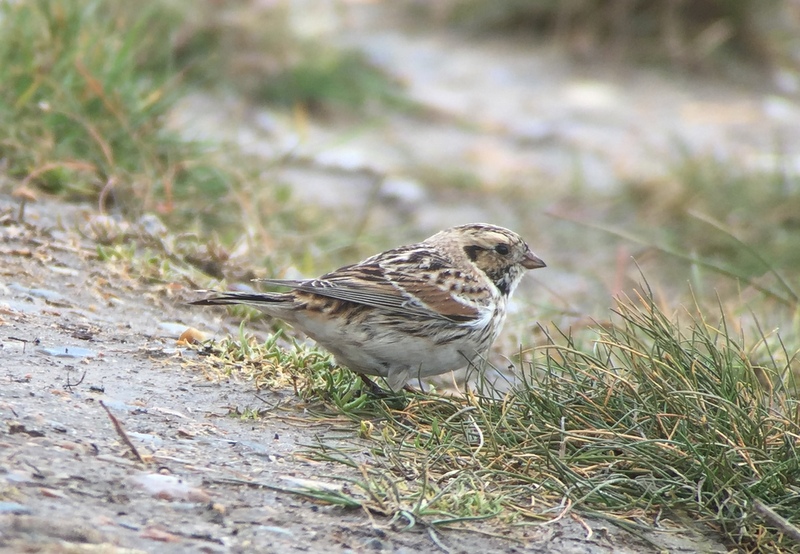 Lapland Bunting – just one remains from the group present over the winter
Lapland Bunting – just one remains from the group present over the winter
There was just enough time to have a quick look in at Cley on our way back.Two Black-tailed Godwits (Uferschnepfe) were squabbling out on the mud, flashing their black tails. Many more were scattered around the water, most now showing variable amounts of bright rusty-orange summer plumage. There were lots of Avocets feeding on the scrape too. A pair just in front of the hide were perfectly synchronised, sweeping their bills from side to side in time. They should soon be settling down to nest on here. A little group of Ruff should be on their way north soon.
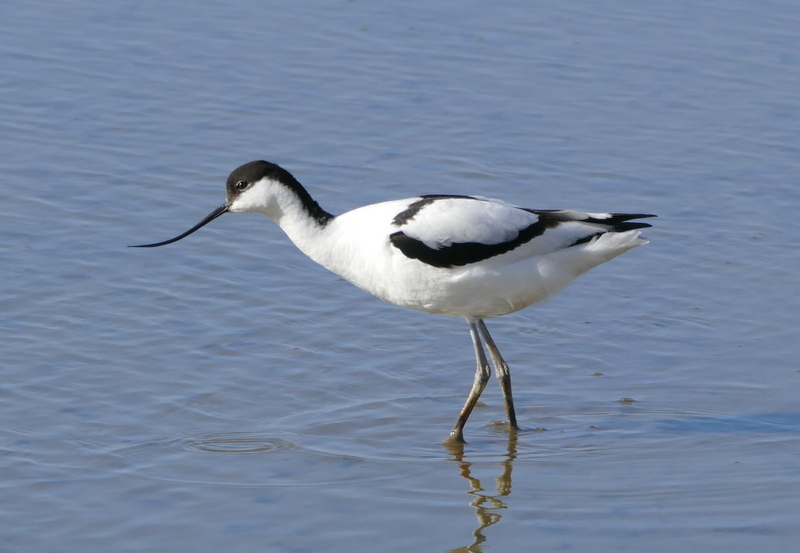 Avocet – should soon be nesting on the scrapes
Avocet – should soon be nesting on the scrapes
A smaller wader right at the front of the scrape was a Green Sandpiper (Waldwasserläufer). A small number spend the winter in Norfolk, mostly inland, but this was most likely a spring migrant, stopping off on its way north.
 Green Sandpiper – a migrant, on its way north
Green Sandpiper – a migrant, on its way north
A small wader further over, on one of the islands, was a lone Dunlin (Alpenstrandläufer), still in grey and white winter plumage. Two other small waders which flew in and landed on the closest island were Little Ringed Plovers (Flussregenpfeifer). They ran round from the back, right to the front of the island where we could see their golden-yellow eye-rings clearly through the scope.
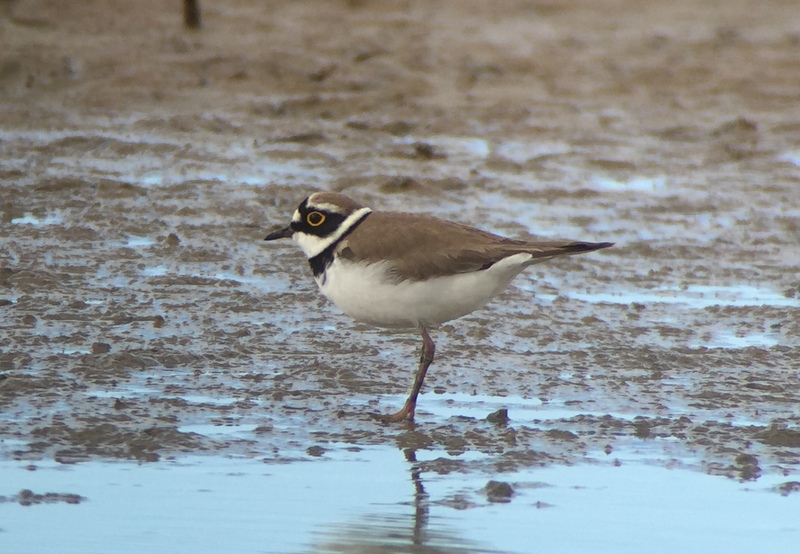 Little Ringed Plover – one of two on the scrape today
Little Ringed Plover – one of two on the scrape today
It was a great way to end the day, with a nice selection of waders. The local Marsh Harriers were soaring over the reedbed and we could hear Bearded Tits (Bartmeise) ‘pinging’ from deep in the reeds, though they were keeping well hidden as usual in the blustery wind. We had been remarkably fortunate with the weather and successfully dodged most of the showers today, seeing quite a few good birds in the process.
















